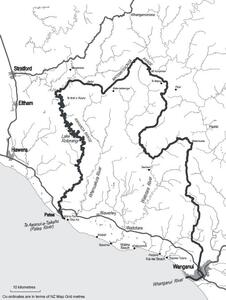Learn about the key aspects of the Ngaa Rauru Kiitahi claims settlement right of first refusal (RFR).
This page is also available for download (PDF).
Note: this is a guide only and agencies must comply with the requirements of the Deed of Settlement, legislation and any relevant LINZ standards.
The following has been developed in collaboration with Te Arawhiti.
The Ngaa Rauru Kiitahi RFR area
Ngaa Rauru Kiitahi is one of eight generally recognised iwi of Taranaki. Rauru is the eponymous ancestor of Ngaa Rauru Kiitahi and it is from him that the tribal name is derived. Ngaa Rauru Kiitahi is located in south Taranaki.
The map below provides an indication of the area of interest for Ngaa Rauru Kiitahi, but is not a depiction of any RFR area.

Map showing the area of interest referred to in the Deed of Settlement between Ngaa Rauru Kiitahi and the Crown.
Settlement summary
Ngaa Rauru Kiitahi received redress through its Treaty settlement with the Crown.
Iwi: Ngaa Rauru Kiitahi
Deed of Settlement signed: 27 November 2003
Ngaa Rauru Kiitahi Deed of Settlement
Settlement Date: 26 July 2005
Legislation: Ngaa Rauru Kiitahi Claims Settlement Act 2005 (“the Act”)
RFR provisions: The RFR provisions are set out in the RFR deed. There are no RFR provisions in the legislation.
Offer made to: The RFR offer is in favour of the trustees of Te Kaahui o Rauru (“the governance entity”)
RFR period: 50 years from the settlement date (expires in 2055)
RFR memorials: No
Definition of RFR property
Clause 14.1 of the RFR deed defines RFR property included in the settlement. It includes every parcel of land within the RFR area (set out in SO 314771 in Schedule 3 of the RFR deed) that, on settlement date, was vested in or held in fee simple by the Crown, or was a Crown-derived reserve vested in an administering body that would revert to the Crown.
RFR property also includes properties obtained in exchange for a disposal of RFR property under clause 6.1.13(a), (b) or (e).
Properties within the RFR area that are listed in the ‘RFR property’ subclause (a)(iii) under clause 14.1 of the RFR deed, any land or roads vested in the Crown by section 44 of the Transit New Zealand Act 1989 (now the Government Roading Powers Act 1989) or any ‘railway assets’ of the Crown within the meaning of paragraph (c) of the meaning of ‘railways assets’ in section 2 of the New Zealand Railways Corporation Restructuring Act 1990 are not included in the settlement as RFR property.
Disposals
The RFR obligation arises for any disposal that:
- transfers or vests the fee simple estate in the land, or
- grants a lease of the land for a term that is, or will be (if any rights of renewal or extension are exercised under the lease), 50 years or longer.
Preliminary notice
There is no requirement to give preliminary notice of a disposal in this settlement.
Offering the land
The RFR offer to the governance entity needs to include the terms of the offer, including:
- the expiry date
- the legal description and street address of the land
- any encumbrances affecting the land
- contact details for the governance entity to respond to.
Expiry date of offer
The RFR offer expires one calendar month after it is received by the governance entity.
Subsequent disposal process
Clause 3 of the RFR deed sets out that if the governance entity does not accept an offer, or the offer period expires, the RFR landowner can dispose of the property provided that:
- the subsequent disposal is not on more favourable terms than those offered to the governance entity
- the land is being disposed of within 2 years after expiry of the RFR offer and
The Crown must, promptly after entering into an agreement to dispose of the RFR property to a purchaser or lessee, give notice to the trustees of that fact and disclose the terms of that agreement. The Crown must not dispose of the RFR property after the end of that 2-year period without first giving notice under clause 1.1 of the RFR deed.
Clause 4 of the RFR deed provides that should the Crown propose to dispose of the RFR property on more favourable terms it may do so only if it first gives another RFR notice to the governance entity.
Exempted disposals
Certain disposals can occur without making an RFR offer to the governance entity. These exempted disposals are set out in clauses 5 and 6 of the RFR deed.
The RFR deed includes specific exemptions in relation to disposal of land that was held for a public work. This land may be disposed of to a local authority under section 50 of the Public Works Act 1981 or any other person where the land will be held or used for the purpose which, immediately before the disposal, constituted the public work.
Where RFR properties are to be disposed of to certain new owners, a deed of covenant may be required to bind new owners to the RFR. The new owner takes on the obligations under the RFR deed. Clause 6 and Schedules 1 and 2 of the RFR deed set out when this is required.
Delivery of notices
Clause 11 of the RFR deed provides for offer notices to be delivered by hand, registered mail or facsimile. There is no provision in the RFR deed for electronic service of an offer.
Contact details
For more information about the Ngaa Rauru Kiitahi claims settlement contact:
Te Kaahui o Rauru
PO Box 18
WAVERLEY 4510
Ngaa Rauru Kiitahi Iwi Trust website
Land Information New Zealand
PO Box 5501
WELLINGTON 6145
Land Information New Zealand website
Te Arawhiti – The Office for Māori Crown Relations
SX10111
WELLINGTON 6011
Te Arawhiti website
postsettlement@tearawhiti.govt.nz
Related Content
Te Kāhui Māngai (Directory of Iwi and Māori Organisations) website